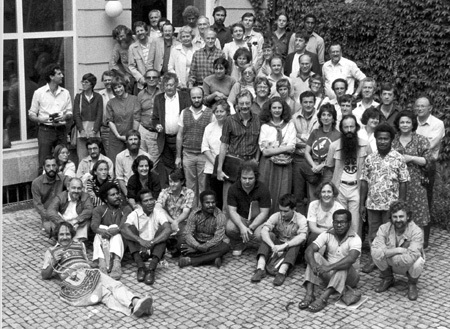Sepik Research Today: The Study of Sepik Cultures in and for Modern Papua New Guinea
Date
Aug 19-26, 1984Organized by
Christian Kaufmann, Nancy Lutkehaus, William Mitchell, Douglas Newton, Lita Osmundsen and Meinhard SchusterLocation
Basel, SwitzerlandPublications
Sepik Heritage: Tradition and Change in Papua New Guinea (N. Lutkehaus, C. Kaufmann, W.E. Mitchell, D. Newton, L. Osmundsen, M. Schuster, Eds.) Carolina Academic Press, Durham, North Carolina, 1990.Participants
- T.C. Aitken Brisbane College of Advanced Education, Australia
- Bryant J. Allen Australian National University
- Ross D. Bowden La Trobe University, Australia
- Lawrence W. Bragge Independent Scholar, Australia
- Christian Coiffier Laboratory for Anthropology and Architecture, France
- Barry Craig Independent Scholar, Papua New Guinea
- Anthony Crawford Robert Brown and Associates, Australia
- Cherubim Dambui East Sepik Provincial Government, Papua New Guinea
- T. Wayne Dye Summer Institute of Linguistics, Papua New Guinea
- Zachary Enda West Sepik Province Government, Papua New Guinea
- Frederick Errington Mount Holyoke College, USA
- Soroi Marepo Eoe National Museum and Art Gallery, Papua New Guinea
- C.S. Filer University of Papua New Guinea
- Anthony Forge Australian National University
- Deborah Gewertz Amherst College, USA
- Chris Haiveta Gulf Provincial Government, Papua New Guinea
- Simon J. Harrison University of Ulster, UK
- Brigitta Hauser-Schäublin Basel University, Switzerland
- Peter Huber Stuart Ford, Inc., USA
- Barbara Huber-Greub University of Basel, Switzerland
- Sasha Josephides University of Warwick, UK
- Bernard Juillerat Centre National de la Recherche Scientifique, France
- Christian Kaufmann Museum für Völkerkunde, Switzerland
- Antje Kelm Hamburgisches Museum für Völkerkunde, Germany
- Donald C. Laycock Australian National University
- David Lea University of New England, Australia
- Gilbert Lewis University of Cambridge, UK
- David Lipset University of California-San Diego, La Jolla, USA
- Diane Losche Australian Museum, Macquarie University, Australia
- Nancy Lutkehaus Columbia University, USA
- Patricia May Australian National University
- Ronald J. May Australian National University
- Nancy McDowell Franklin and Marshall College, USA
- Rhoda Métraux American Museum of Natural History, USA
- William Mitchell University of Vermont, USA
- Douglas Newton Metropolitan Museum of Art, USA
- Brigit Obrist University of Basel, Switzerland
- Lita Osmundsen Wenner-Gren Foundation, USA
- Hanns Peter Museum für Völkerkunde, Austria
- Hushang Philsooph University of Edinburgh, UK
- Paul Roscoe American Museum of Natural History, USA
- Richard Scaglion University of Pittsburgh, USA
- Markus Schindlbeck Museum für Völkerkunde, West Germany
- Jurg Schmid Universität Basel, Switzerland
- Gisela Schuster Universität Basel, Switzerland
- Meinhard Schuster Universität Basel, Switzerland
- Johathan Sengi East Sepik Province, Papua New Guinea
- Dirk Smidt Rijksmuseum voor Volkenkunde, The Netherlands
- Michael French Smith Public Sector Consultants, Inc., USA
- Gordon Spearritt University of Queensland, Australia
- Milan Stanek University of Zurich, Switzerland
- Werner Stöcklin-Frey Swiss Tropical Institute, Switzerland
- Andrew Strathern Institute of Papua New Guinea Studies
- Pamela Swadling National Museum, Papua New Guinea
- Mary Taylor Woodrow Wilson School, Princeton, USA
- Patricia Townsend Institute of Applied Social and Economic Research, Papua New Guinea
- Margaret Tuckson The Pottery, Wahroonga, Australia
- Donald F. Tuzin University of California-San Diego, La Jolla, USA
- John Wasori East Sepik Province, Papua New Guinea
- Jürg Wassmann Universität Basel, Switzerland
- Florence Weiss Universität Basel, Switzerland
- Margaret Williamson Mary Washington College, USA
ORGANIZER’S STATEMENT: The idea of the conference, as gradually developed and eventually expressed in its subtitle “The Study of Sepik Cultures in and for Modem Papua New Guinea,” was to offer a framework for reflecting, through precirculated papers, discussions, and this publication, on the role that the anthropological research done so far or planned for the future in the Sepik might play in the young nation of Papua New Guinea. This was not, of course, seen as a matter of reducing anthropology to economic development, social work, or politics. Rather, the idea was to consider what the study of traditional Sepik cultures, including historical questions, could contribute to an understanding of the present situation and, from a broader perspective, to the building of a multiethnic nation.
This topic might have been treated by a small group of scholars on the basis of examples drawn from their own or other people’s research, but because there was so much anthropological fieldwork going on in the Sepik we considered it more appropriate to put the question implied by the phrase “in and for modern Papua New Guinea” to everyone who had done research in the Sepik in recent times. By doing so, we felt, we could highlight the national framework within which all anthropological research now takes place and at the same time obtain a relatively complete picture of the state of Sepik research that would also be of interest to the Papua New Guinea authorities.
It was decided that every anthropologist, geographer, art historian, and linguist who had done fieldwork in the Sepik since about 1960, published about it, and remained actively in contact with the discipline would be invited. We defined “Sepik” as covering the whole triangle between the north coast (including the Schouten Islands), the border with Irian Jaya, and the lower northern slopes of the central mountain range, thus excluding the Telefomin area even though it is part of the West Sepik Province but going beyond the East Sepik Province into the Ramu area of Madang Province.
(excerpt from “Sepik Heritage” prologue by Meinhard Schuster)
Wenner-Gren Symposium #95
